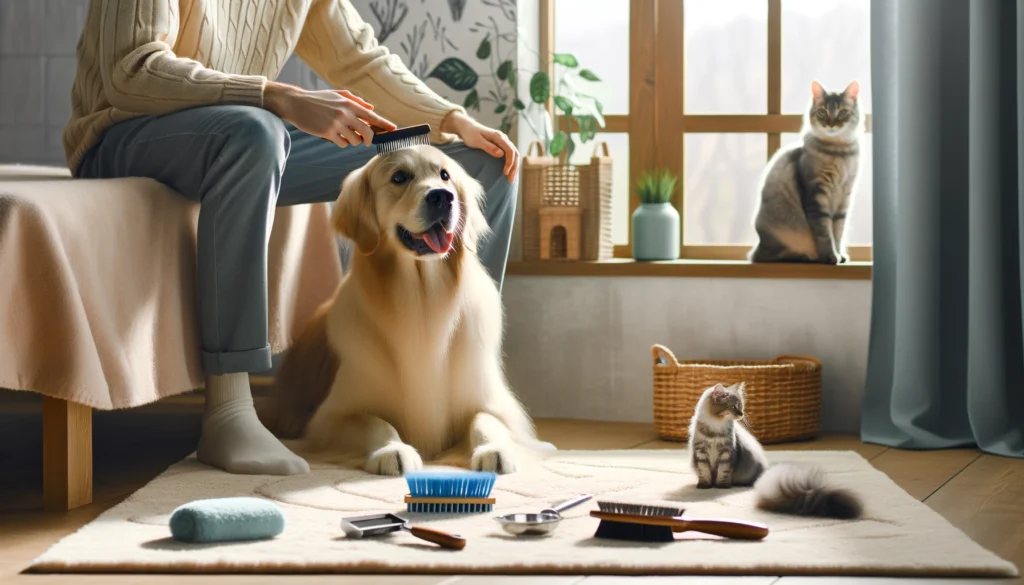Brushing your dog or cat isn’t just about keeping them looking good — it’s essential for their health and comfort. Regular grooming helps reduce shedding, prevents painful mats, and is a great opportunity to bond with your pet.
Whether you have a fluffy cat or a short-haired dog, here are practical tips to make brushing at home simple, stress-free, and effective.
Why Brushing Is So Important
Brushing your pet’s fur regularly offers many benefits:
- Reduces shedding and fur buildup in the home
- Prevents mats and tangles that can lead to discomfort or skin issues
- Stimulates skin circulation and distributes natural oils for a shiny coat
- Gives you a chance to spot health issues, such as bumps, parasites, or dry skin
- Improves bonding through gentle physical contact
Choose the Right Brush for Your Pet
Different pets (and coat types) need different tools. Choosing the right brush will make the process more efficient and enjoyable.
For Dogs:
- Short-haired dogs: Use a rubber curry brush or bristle brush.
- Long-haired dogs: A slicker brush and a comb work best for detangling and removing loose fur.
- Double-coated breeds: Use an undercoat rake to remove dead hair beneath the topcoat.
For Cats:
- Short-haired cats: A soft-bristled brush or grooming glove works well.
- Long-haired cats: Use a wide-toothed comb and a slicker brush to tackle tangles.
- Senior or sensitive cats: Opt for a rubber brush or grooming mitt for gentleness.
Brush Regularly, But Not Excessively
The frequency of brushing depends on the type of coat your pet has:
- Short hair: Once or twice a week is usually enough.
- Medium to long hair: Brush every day or every other day to prevent mats.
- Shedding season: During spring and fall, increase brushing frequency to manage excess fur.
Consistency helps your pet get used to the process and reduces the amount of fur in your home.
Make It a Positive Experience
Brushing should be a calm, rewarding routine — not a struggle.
- Start slow: Let your pet sniff the brush and get comfortable.
- Choose a quiet time: Avoid brushing when your pet is overly energetic or anxious.
- Use praise and treats: Reward them during and after the session to create a positive association.
- Keep it short: Start with a few minutes and gradually increase the time.
Use Gentle Technique
How you brush matters just as much as how often.
- Brush in the direction of the fur: Avoid going against the grain, which can pull and cause discomfort.
- Be extra gentle around sensitive areas: Such as the face, belly, and tail.
- Don’t pull mats: Gently work through tangles with a detangling spray and a comb. Severe mats may need to be trimmed by a groomer.
Set Up a Comfortable Grooming Spot
Make brushing part of your home routine in a calm, pet-friendly space.
- Use a non-slip mat: Especially helpful if grooming on a table or countertop.
- Keep tools nearby: Store brushes, combs, and wipes in a grooming kit.
- Use natural light: It helps you see what you’re doing and keeps your pet relaxed.
Watch for Skin or Coat Issues
Brushing helps you keep an eye on your pet’s skin and coat health.
- Look for flakes, redness, or bumps
- Check for ticks or fleas
- Note any hair loss or signs of irritation
If you notice anything unusual, contact your vet for guidance.
Clean Your Grooming Tools Regularly
Dirty brushes can spread bacteria and dirt back onto your pet.
- Remove hair after each session
- Wash brushes weekly with mild soap and warm water
- Let them air dry completely before storing
Be Patient with Nervous Pets
If your pet isn’t used to brushing, take extra time to build trust.
- Start with petting before using any tool
- Let them move freely at first — don’t force them to stay still
- End on a good note every time, even if the session is short
Building positive experiences over time will reduce resistance and turn brushing into a moment your pet actually enjoys.
Final Thoughts: Grooming Is Love in Action
Brushing your pet at home is more than grooming — it’s a gesture of care, attention, and affection. With the right tools, patience, and routine, you’ll not only improve your pet’s health but also deepen your connection with them.
Start small, stay consistent, and celebrate the little wins — a smooth, healthy coat is just the beginning.






